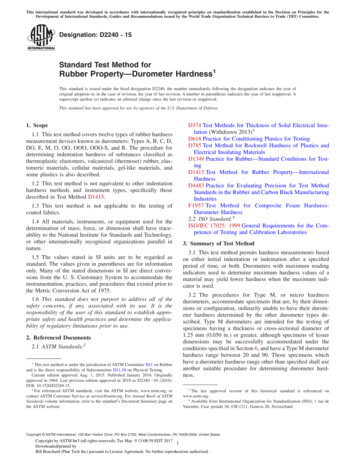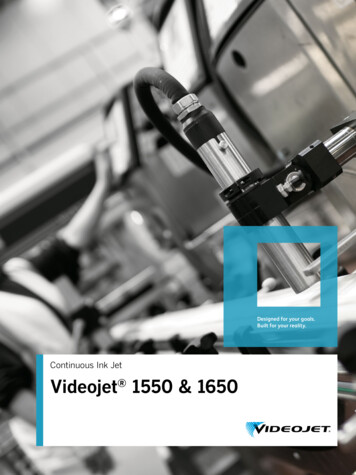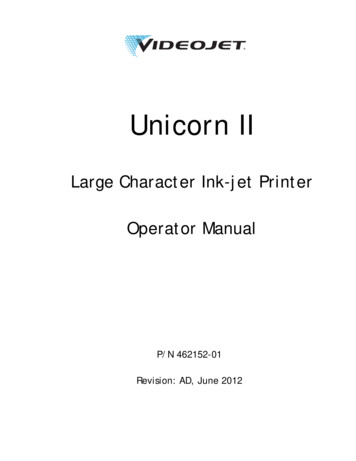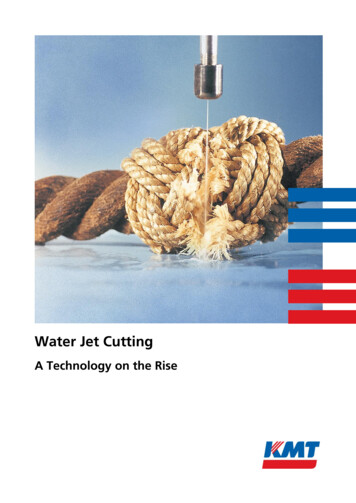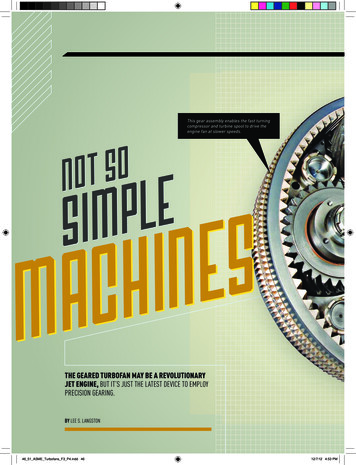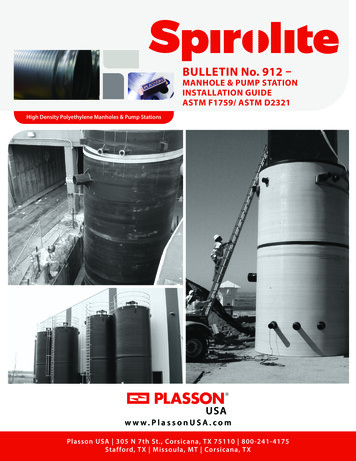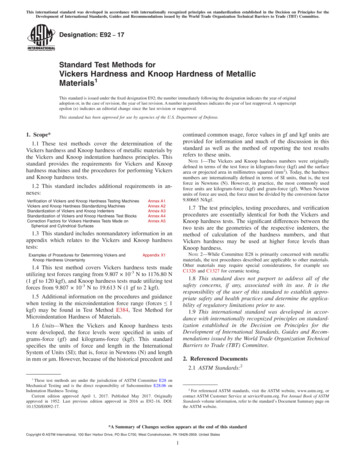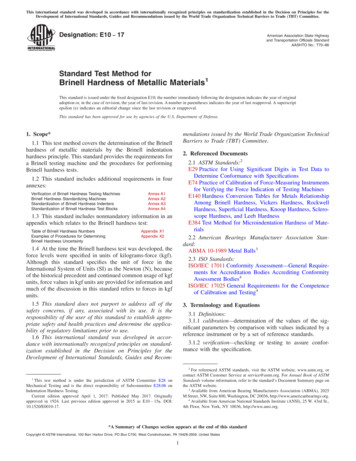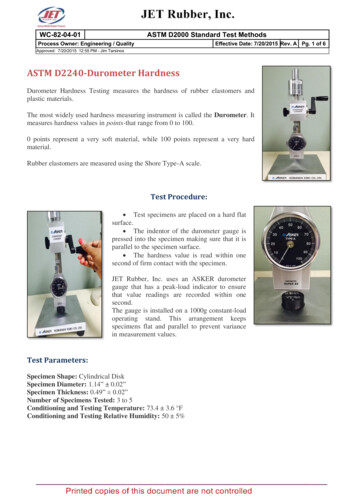
Transcription
WC-82-04-01ASTM D2000 Standard Test MethodsProcess Owner: Engineering / QualityEffective Date: 7/20/2015 Rev. A Pg. 1 of 6Approved: 7/20/2015 12:55 PM - Jim TarsinosASTM D2240-Durometer HardnessDurometer Hardness Testing measures the hardness of rubber elastomers andplastic materials.The most widely used hardness measuring instrument is called the Durometer. Itmeasures hardness values in points-that range from 0 to 100.0 points represent a very soft material, while 100 points represent a very hardmaterial.Rubber elastomers are measured using the Shore Type-A scale.Test Procedure: Test specimens are placed on a hard flatsurface. The indentor of the durometer gauge ispressed into the specimen making sure that it isparallel to the specimen surface. The hardness value is read within onesecond of firm contact with the specimen.JET Rubber, Inc. uses an ASKER durometergauge that has a peak-load indicator to ensurethat value readings are recorded within onesecond.The gauge is installed on a 1000g constant-loadoperating stand. This arrangement keepsspecimens flat and parallel to prevent variancein measurement values.Test Parameters:Specimen Shape: Cylindrical DiskSpecimen Diameter: 1.14” 0.02”Specimen Thickness: 0.49” 0.02”Number of Specimens Tested: 3 to 5Conditioning and Testing Temperature: 73.4 3.6 FConditioning and Testing Relative Humidity: 50 5%
WC-82-04-01ASTM D2000 Standard Test MethodsRev. A Pg. 2 of 6ASTM D395 Compression SetCompression Set Testing determines the ability of an elastomericmaterial to maintain its elastic properties after exposure toprolonged compressive stress.ASTM D-395 describes two types of Compression set tests: Method A, compression set under constant load; and Method B, compression set at constant deflection of 25%.JET Rubber, performs Compression testing using method B.Test Procedure: The thickness of the original specimen ismeasured and recorded.The specimen in then placed between theplates of the compression set assembly.The specimen is compressed to 75% of itsoriginal height. Spacers are used to ensure thatthe compression force is accuratelymaintained.The loaded compression set assembly is placedin an oven at a specified temperature for thesuggested periods of 22 hours or 70 hours.The specimen is removed from the oven andconditioned for 30 minutes on a wooden plank.The final thickness of the specimen is thenmeasured.Compression set is expressed as a percentage of the original deflection and is calculated using thefollowing formula:CB Compression Setto Original thickness of the specimenti Final thickness of the specimentn Thickness of the space barsTypical Test Parameters:Specimen Shape: Cylindrical DiskSpecimen Diameter: 1.14” 0.02”Specimen Thickness: 0.49” 0.02”Number of Specimen Tested: 2 or 3Conditioning and Testing Temperature: 73.4 3.6 FConditioning and Testing Relative Humidity: 50 5%
WC-82-04-01ASTM D2000 Standard Test MethodsRev. A Pg. 3 of 6ASTM D412 TensionThis test method evaluates the tensileproperties of vulcanized thermoset rubbersand thermoplastic elastomers and describestwo types of Tension tests: Method A, using dumbbells andstraight section specimens; and Method B, using cut ring specimens.To determine tension properties such astensile strength, ultimate elongation, yieldpoint, yield strain and yield stress, JETRubber, Inc. uses an Instron 3365 testingmachine equipped with Blue Hill software.Test Procedure: Using a standard dumbbell specimencutting die, five specimens are cut from avulcanized sheet prepared to ASTM D3182and ASTM D3183 procedures. The dumbbells are conditioned for atleast 30 minutes prior to beginning the test. The thickness of the reduced (gaugelength) section of the dumbbells is measuredand recorded. The specimen is carefully placed betweenthe grips of the testing machine to provideuniform alignment. An extensometer is used to grip thespecimen at the reduced section of thedumbbell. The testing machine is activated and thegrips begin to separate at the rate of 20 2inches/minute. Thetestends once thespecimenbreaks.TypicalTest Parameters:Specimen Shape: DumbbellSpecimen Gauge Length: 1.31”Specimen Thickness: 0.08” 0.008”Number of Specimen Tested: 5Conditioning and Testing Temperature:73.4 3.6 FConditioning and Testing RelativeHumidity: 50 5%
WC-82-04-01ASTM D2000 Standard Test MethodsASTM D624 Tear StrengthThis test method measures the property resistance of vulcanized rubberand thermoplastic elastomers knownas ‘tear strength’.Tear strength is measured using theforce per unit thickness required torupture,initiate or propogate a tearthrough the specimen tested.To perform Tear Strength Testing,JET Rubber, Inc. uses an Instron3365 testing machine equipped withBlue Hill software. Test Procedure:Using a type ‘C’ specimen cutting die, five specimens are cut froma vulcanized sheet, prepared to ASTM D3182 and ASTM D3183procedures.The specimens are conditioned for at least 30 minutes prior totesting.The thickness of the specimen at the apex is measured andrecorded.The specimen is carefully placed between the grips of the testingmachine to provide uniform alignment.The testing machine is activated and the grips begin to separate atthe rate of 20 2 inches/minute.The test ends once the specimen breaks.Typical Test Parameters:Specimen Shape: Die “C” cut specimenNumber of Specimen Tested: 5Conditioning and Testing Temperature: 73.4 3.6 FConditioning and Testing Relative Humidity: 50 5%Rev. A Pg. 4 of 6
WC-82-04-01ASTM D2000 Standard Test MethodsRev. A Pg. 5 of 6ASTM D2084 Vulcanization Using Oscillating Disc Cure MeterThis test method describes the use of the ODR- oscillating disk cure meter.Jet Rubber, Inc. uses a Monsanto R-100 ODR, equipped with MonControlSoftware to measure the curing and processing characteristics ofvulcanizable rubber compounds.Test Procedure:A test specimen of vulcanizable rubbercompound is inserted into the ODR testcavity. After the ODR closes, it is containedin a sealed cavity under positive pressure. The cavity is heated to a specifiedtemperature. The rubber completely surrounds thebi-conical disk after the platens are closed The disk oscillates at small rotaryamplitude (1 /3 ) to exert a shear strain onthe test specimen. The test is completed when therecorded torque either rises to anequilibrium or maximum value, or when a predetermined time haselapsed.Typical Test Parameters:Number of Specimen Tested: 1-3Conditioning Temperature: 73.4 3.6 FConditioning and Testing Relative Humidity: 50 5%
WC-82-04-01ASTM D2000 Standard Test MethodsASTM D297 – DensityThis test method determines the density of a vulcanized specimen, knowas ‘Specific Gravity’. The standard includes the following methods: Pycnometer Method;Hydrostatic Method; andCompressed Volume Densimeter Method.JET Rubber, Inc. uses the Hydrostatic Method to determine the densityor ‘Specific Gravity ‘of vulcanized rubber.Test Procedure The mass of a specimen disc is measured.A beaker is filled with de-ionized water and placed in a universalspecific gravity kit as shown.A milligram balance is used to determine density. The mass of the specimen in air-Air (g) is measured. The mass of the specimen in water- Water (g) is measured.‘Specific Gravity ‘is calculated using the following formula:Test ParametersSpecimen Shape: Cylindrical DiskSpecimen Diameter: 1.14” 0.02”Specimen Thickness: 0.49” 0.02”Number of Specimen Tested: 1Conditioning and Testing Temperature: 76.1 F – 77.9 FRev. A Pg. 6 of 6
ASTM D2240-Durometer Hardness Durometer Hardness Testing measures the hardness of rubber elastomers and plastic materials. The most widely used hardness measuring instrument is called the Durometer. It measures hardness values in points-that range from 0 to 100. 0 points represent a very soft material, while 100 points represent a very hard material. Rubber elastomers are measured using the .
